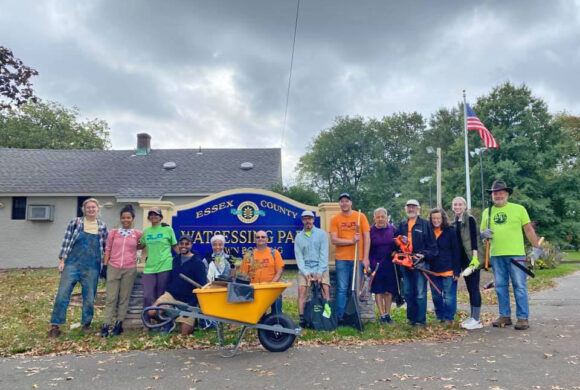Volunteer Stewardship Teams
Making a difference one park at a time!
Dedicated volunteers have enormous power to improve the ecological health of parks and the Strike Team wants to assist them! Volunteer Stewardship Teams are needed to support state, county, municipal, and non-profit conservation lands that do not have enough staff resources to meet the challenge of invasive species. The work of dedicated volunteers doesn’t just impact a particular park, it generates interest and concern across their communities, motivating people to plant natives and avoid invasives in their yards and encouraging their local governments to contribute toward solutions.
Early in my career a colleague pointed me to this quote, there is no doubt that it is true, and it’s exemplified by Volunteer Stewardship Teams.
“The lesson I take from more than a decade of volunteer and professional land stewardship is that remarkable progress is the predictable result of steady, low-technology land management.” – Jennifer Hillmer, Land Steward
Find a Team Near You!
Burlington County
• Bordentown City Environmental Commission (1)
• Friends of Abbott Marshlands (25)
Essex County
• Bonsal Wildlife Preserve (24)
• Friends of Watsessing Park (5)
• Morris Canal Greenway Committee (12)
• South Mountain Conservancy Forest Regeneration Team (20)
• South Orange Environmental Commission and Shade Tree Committee (21)
Mercer County
• Ridgeview Conservancy (23)
• Washington Crossing Park Association (28)
Middlesex County
Monmouth County
• Monmouth County Parks (30)
• Monmouth Invasive Species Strike Team – Joe Palaia Park (8)
• Monmouth Invasive Species Strike Team – Colts Neck Town Hall Arboretum (9)
• Monmouth Invasive Species Strike Team – Bliss Arboretum (10)
• Monmouth Invasive Species Strike Team – Jackson Woods (11)
• Sea Girt Conservancy – Crescent Park (17)
• Sea Girt Conservancy – Edgemere Park (18)
• Third Street Trail (26)
Morris County
• Burnham Park Association (29)
• Friends of Foote’s Pond Wood (4)
• Great Swamp National Wildlife Refuge Strike Team (6)
• Great Swamp Watershed Association (7)
• New York-New Jersey Trail Conference Invasives Strike Force – Pyramid Mountain (14)
• Rock Ridge Lake Association (27)
Passaic County
• Clifton Environmental Commission (32)
• Paterson Great Falls, Ramapo College (16)
Somerset County
• Somerset Environmental Education Center Invasive Species Strike Team (19)
CLICK HERE to learn about New Jersey’s Volunteer Stewardship Teams
Contact Mike to have your group added.
in a Nutshell
- Good communication with landowner
- Core of 1-3 group leaders and a pool of at least 10-15 available volunteers
- Predictable workdays (e.g., every other Saturday from 9am-Noon) allowing a larger volunteer pool to plug into efforts as their time allows.
- Schedule year round with timing determined by weather
- Create and follow a concise long-term plan with annual work plans that identify digestible tasks that can be ‘checked off’ (e.g., removal of all individuals of an emerging invasive species or remove all invasives from a particularly high value area with few invasive species)
- Successful removal always involves planning and follow up
- Include the fun stuff too! Invasive control alone is much less rewarding without some planting of native trees, shrubs, and wildflowers. Successful restoration requires dealing with deer overabundance – consider deer resistant species or plant protection options.
- Lean on each other’s expertise! Many groups have supported formation of other groups and regularly help each other.
- See below for additional details.
- Get plan approval from the landowners and keep them updated
- Document before, during and after with photos.
- Balance planting natives and removing invasives as much as possible.
- Mike can help groups develop plans including a training workshop and providing a concise set of recommendations that prioritize species and areas within a park.
- For our basic plan, we request a $250 donation for a 2-3 hour workshop followed up with a plan, but free advice awaits anyone that reaches out to Mike by phone or email. We can develop a quote for more detailed plans for larger parks.
- Example: Bliss Arboretum
- Example: Bordentown City (multiple parks)
- Example: Brightwood Park
- Example: Glenside Woods
- Example: Jones Woods
- Example: Monmouth Invasive Species Strike Team Colts Neck
- Example: Monmouth Invasive Species Strike Team Joe Palaia Park
- Example: Rock Ridge Lake
- Example: Sea Girt Conservancy
- Example: Third Street Trail
- Example: Washington Crossing Park Association
Volunteer Recruitment and Retention
- Recruit using positive messages, talking about “habitat enhancement/integrated vegetation management” instead of solely focusing on invasive control. Utilize social media, flyers in kiosks, etc.
- Keep in mind that high schoolers require community service hours and local corporations often seek volunteer opportunities.
- Consider tools like SignUP Genius to make communication and scheduling easier
- Retention is enhanced with regular communications and volunteer appreciation gatherings.
- Make sure that appropriate waivers and approvals are in place based upon landowner requirements.
- Training and safety are important, utilize web resources and reinforce during workdays, especially for new volunteers.
- Clearly explain the appropriate attire for the tasks at hand, what they should bring, and what will be provided.
- Match volunteers to jobs (e.g., Scouts pull garlic mustard, High School students/corporate volunteers like to see progress and use tools).
- Explain, teach, and enroll, don’t just assign work.
- Each volunteer should stop and rest BEFORE they are physically or mentally “finished”. End each workday on schedule. Working overtime burns out volunteers.
- Chatter and small talk are really important even if it slows the pace – this is a fun team activity, not forced labor.
- Enjoy and celebrate accomplishments!
- Make sure volunteers have water, safe clothing choices, safety glasses, flagging, tick spray, poison-ivy prevention (e.g., Technu), rakes, hoes, loppers, pruners, saws, garbage bags, heavy duty gloves, etc. Ideally the landowner or project leaders will provide many or most of the tools and accessories.
- Mechanical control methods require more work but with persistence can be completely effective at a small to medium scale against even the most aggressive invaders.
- Many community teams successfully working on public properties are constrained to only use mechanical methods
- Mechanical control methods are the only protocols that should be assigned to beginners and novices.
- Properly targeted herbicides can significantly improve progress scope and success. The use of herbicides should only be done with proper training under the supervision of landowner staff or contractors that are Certified Pesticide Applicators registered with the NJ Department of Environmental Protection.
- The specific treatment protocol and herbicides must be supplied by the licensed supervisor along with sprayers, measuring cups, nitrile gloves, etc. The supervisor is also responsible for treatment documentation and to assure safe storage, mixing, and disposal areas.
Resources
- Network with other teams addressing similar challenges. We all learn from each other!
- The New Jersey Invasive Species Strike Team provides regularly updated resources including species fact sheets, species-specific control recommendations, and an herbicide mixing table.
- The EDDMapS phone app is a great way to record observations and it contains photos and plant descriptions to help with identification – select “New Jersey” to get our customized list.
- We strongly encourage it use! This is how the Strike Team learns about invasive distribution across the state.
- There are multiple plant identification apps to help you learn. iNaturalist includes all plants and more. You can set up a project for your park and share all of the great natural history, not just the invasives.
- New York/New Jersey Invasive Species Strike Force resources
- Lower Hudson PRISM resources
- Uninvited: The Spread of Invasive Species video
- Connecticut Invasive Plant Working Group plant management calendar
- Penn State invasive plant fact sheets
For More Information




